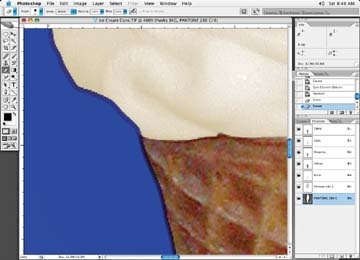Trapping on Special Packaging
As I mentioned earlier in Chapter 5, when printing on various packaging materials, it can be difficult for a press to register all the colors. Imagine a plastic bread bag material traveling through a press, and you might get the picture. The end result is that the picture elements of different colors or various bits and pieces of the image printed on different printing plates may not line up or register properly with one another. This misalignment results in the background of the material showing through parts of the image, or one color bleeding over another with a gap on the opposing side. You have probably seen this effect.

Figure 9-21. The look of a trap on the ice cream image (exaggerated here so you get the idea)
Note
Keep in mind that you may want to check with the people preparing the final packaging files prior to adding trap. Many high-end packaging programs will allow the packaging operator to add trap on their end, making it unnecessary for you to do so. However, you may be asked to add trap, although this isn't typical. Trapping is covered in Chapter 5.
In an effort to correct this problem, a certain amount of extra image surrounding a picture element is added, called trap. Trap is added to picture elements so that if a shift occurs, the gaps are prevented because the trap between elements fills in this potential error (Figure 9-21).
When ...
Get Commercial Photoshop Retouching: In the Studio now with the O’Reilly learning platform.
O’Reilly members experience books, live events, courses curated by job role, and more from O’Reilly and nearly 200 top publishers.

